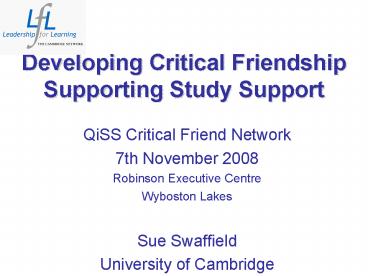Developing Critical Friendship Supporting Study Support - PowerPoint PPT Presentation
1 / 35
Title:
Developing Critical Friendship Supporting Study Support
Description:
levels of learning. Student learning. Professional learning. School learning. System learning ... Collaborative activity across boundaries of subject, role and ... – PowerPoint PPT presentation
Number of Views:31
Avg rating:3.0/5.0
Title: Developing Critical Friendship Supporting Study Support
1
Developing Critical FriendshipSupporting Study
Support
- QiSS Critical Friend Network
- 7th November 2008
- Robinson Executive Centre
- Wyboston Lakes
- Sue Swaffield
- University of Cambridge
2
Overview
- Deepening understanding of critical friendship
through the lens of leadership for learning
principles - Implications for QiSS Critical Friends
- Role clarity - similarities and differences with
other roles
3
CARPE VITAM Leadership for Learning
- International
- Context sensitive
- Value-based
- Action learning
- Collaborative
- Critical friendship
- Practical theory
4
LEARNING
LEADERSHIP
5
LEARNINGActivityDispersed
AGENCY
LEADERSHIPActivityDistributed
6
MORAL PURPOSE
LEARNINGActivityDispersed
AGENCY
LEADERSHIPActivityDistributed
7
Five Principles for Practice
- A Focus on Learning
- Conditions for Learning
- Dialogue
- Shared Leadership
- Shared Accountability
8
Moral Purpose
Moral Purpose
Moral Purpose
Conditions for learning
Focus on learning
Leadership as activity
Learning as activity
Agency
Shared leadership
Shared accountability
Dialogue
Moral Purpose
9
1. Leadership for learning practice involves
maintaining a focus on learning as an activity
10
A Focus on Learning
- Everyone is a learner
11
Interconnected levels of learning
Student learning
Professional learning
School learning
System learning
12
A Focus on Learning
- Everyone is a learner
- Learning relies on the effective interplay of
social, emotional and cognitive processes - The efficacy of learning is highly sensitive to
the context and to the differing ways in which
people learn - The capacity for leadership arises out of
powerful learning experiences - Opportunities for leadership enhance learning
13
Focus on learningand critical friends
- Different conceptions of learning
- Critical friends learning
- Keeping learning as the focus, amongst the
busyness and urgent pressures
14
2. Leadership for learning practice involves
creating conditions favourable to learning as
an activity
15
Conditions for Learning
- Environment for learning
- Material and physical space
- Affective and cognitive skills and dispositions
- Cultural and structural conditions
16
Conditions for learning and critical friends
- TrustSafety to take risks, cope with failure,
respond positively to new challenges - Shared values
- Common understanding of purpose
- Knowing the contextBeing known
17
3. Leadership for learning practice involves
creating a dialogue about leadership for
learning
18
Meaning flowing throughnot Discussion
tearing to bitsDisciplined dialogue
19
Dialogue
- Practice made explicit, discussable and
transferable - Collective enquiry
- Coherence through sharing of values,
understandings and practices - Factors that inhibit and promote learning are
examined and addressed - Link between leadership and learning is a concern
for all - Different perspectives explored through
networking across boundaries
20
Professionals in dialogue(Alexander, 2004)
- Listen without interruption?
- Respect others viewpoint, or status wisdom?
- Collective problem solving, or own agendas?
- Stick to topic, or digress?
- Able to speculate without fear of being
sidelined? - Ask probing questions, or merely pass on ideas?
- Prepared to suspend disbelief in relation to the
novel or unfamiliar? - Take thinking forward, or going around in
circles?
21
Dialogue and critical friends
- Initiating dialogue - drawing attention to good
practice -gt further enhancement - Tools and routines for stimulating and enhancing
dialogue - Recognising the stages of developing dialogue
- Openness and willingness to engage and reframe
22
4. Leadership for learning practice involves
the sharing of leadership
23
Hierarchical structures formal
delegationFluid spontaneous dispersed forms
of leadership
24
Sharing of leadership
- Structures support participation in developing
learning communities - Shared leadership symbolised in day-to-day flow
of activities - Everyone encouraged to take a lead as appropriate
to task and context - Everyones experience and expertise drawn on
- Collaborative activity across boundaries of
subject, role and status valued and promoted
25
5. Leadership for learning practice involves a
shared sense of accountability
26
Shared sense of Accountability
- Systematic approach to self-evaluation embedded
at every level - Focus on evidence and its congruence with core
values - Shared approach to internal accountability a
precondition of external accountability - National policies recast in accordance with
values - Choosing how to tell own story, taking account of
political realities - Continuing focus on sustainability, success and
leaving a legacy
27
What insights do the Leadership for Learning
principles provide for our work as critical
friends?
28
How does / cancritical friendshipcontribute
toorganisational improvement?
29
- Critical friend SIP Coach
- Mentor
30
- Critical friend SIP Coach
- Mentor
31
- Critical friend SIP Coach
- Mentor
32
Similarities differences
33
Essential features of critical friendship
- Trust at the core
- Focuses on a professional endeavour, going beyond
the individual - Questioning to provoke insight and reflection is
key process - Provides an alternative perspective
- An element of detachment
34
Critical friendshipSome issues
- Selection and choice of critical friend
- Establishing and sustaining the relationship,
especially trust - Purpose and focus Boundaries
- Too friendly or too critical?
- Whose friend? Multiple or competing agendas?
- Critical friends knowledge, experience and
skills - Training and support
35
References
- Alexander, R. (2004) Towards dialogic teaching
rethinking classroom talk. Cambridge Dialogues. - MacBeath, J., Frost, D., Swaffield, S. and
Waterhouse, J. (2006) The story of a seven
country odyssey in search of a practical theory.
Cambridge University of Cambridge Faculty of
Education. - MacBeath, J. and Dempster, N. (eds) (2008)
Connecting Leadership and Learning Principles
for practice. London Routledge. - Swaffield, S. (2007) What is distinctive about
critical friendship? Paper presented at the 20th
ICSEI, Portoroz. - Swaffield, S. (2008) Critical friendship,
dialogue and learning, in the context of
Leadership for Learning. School Leadership and
Management 28 (4) 323-336. - www.leadershipforlearning.org.uk
- www.educ.cam.ac.uk/research/projects/lfl/































